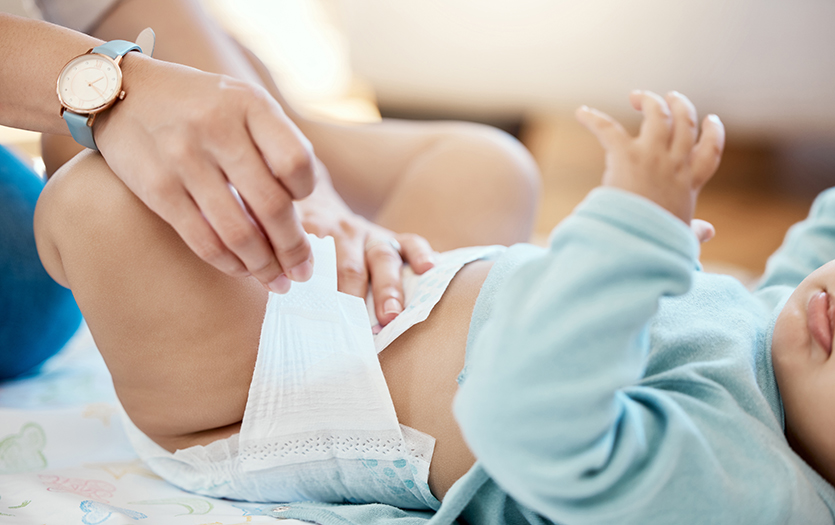
This post was written by Rafael Nunez Alvarado, MD, PPG – Pediatrics.
No parent wants to see their baby in pain. Of the many conditions I see in my office, diaper rash (also called diaper dermatitis) is one of the more common issues leading to discomfort for infants and toddlers. Here, I address the questions I often get from concerned caregivers wanting to prevent and treat redness, rash or irritation on the skin covered by a diaper.
How common is diaper rash?
It’s one of the most common conditions in pediatric patients. According to the American Academy of Pediatrics, at least half of all infants and toddlers will be affected at some point.
What does diaper rash look like?
It’s most often in the diaper area, including the perineum, though it can also involve the thighs. Diaper rash typically presents as an area of erythema (redness), irritation and/or scaling.
What are the most common symptoms of diaper rash?
In most cases, diaper rash presents as erythematous (red patches), irritation, scaling and, in some cases, skin erosion, involving the diaper area, thighs and even the lower part of the abdomen. Theses rashes usually spare the inguinal creases (folds in the tops of baby’s legs).
If your infant gets frequent diaper rashes, they can be superinfected by a yeast infection (candida albicans), causing the rash to appear more severe and spread to the areas usually spared by a simple rash, such as the inguinal creases.
Are there different types of diaper rash?
Diaper rashes could be classified as secondary to systemic illness in some cases. When a rash does not look conventional, spreads to other areas of the body or does not respond to conventional treatment, it’s important to discuss the symptoms with your baby’s primary care doctor so that you can explore other probable causes of diaper rash. The irritation could be linked to, for example: seborrheic dermatitis, impetigo, folliculitis, intertrigo, etc. In some cases, consultation with a dermatologist or infectious diseases specialist may be necessary.
How can I treat my baby’s diaper rash?
Since most diaper rashes are caused by irritation of the diaper area, treatment is mostly targeted to reduce moisture in the diaper area and prevent friction. Recommendations include:
Frequent diaper changes – When we leave the area exposed to a soiled or dirty diaper for an extended period, skin is more likely to get irritated. That is caused by the chemicals produced from the urine and the enzymes in the stools. Increasing the frequency of diaper changes can prevent prolonged exposure.
Cleaning gently while changing the diaper – It’s important to select products that are gentle on the skin. Wipes should be as neutral as possible, without any fragrance, preservatives or additives, such as alcohol. A washcloth with water and soap can also be used. When rashes are severe, wiping the skin excessively can cause more irritation and pain. Be sure to allow the skin to dry completely before putting on a new diaper.
Use a protective barrier – This means minimizing the exposure of the skin to stools, urine and irritants by applying creams or paste. These products work by adhering to the skin, creating a protective layer. The most important ingredients in these creams are zinc oxide and petrolatum. Make sure, just like with wipes, that these diaper creams are fragrance free. Always apply a thick layer that covers all the possible exposed areas. Allow the skin to dry completely after cleaning, and then apply the diaper cream.
Use highly absorbent diapers – Diapers work by absorbing moisture and keeping the area dry. The more absorbent the diaper, the better it is for preventing diaper rashes.
Allow the skin to breathe – In some cases, allowing diaper-free periods helps the skin heal faster. This may not be an option for every child, but if possible, can promote drying and healing. Also, always make sure you don’t put the diaper on too tight.
When should I see a provider about my child’s diaper rash?
When a rash does not respond to the treatments and/or presents for longer than 72 hours (about three days), you should see your doctor to rule out a yeast infection. If the rash is severe, is spreading to other parts of the body, or does not look like the typical diaper dermatitis, you should also make an appointment with your baby’s primary doctor.
How can I prevent diaper rash?
The most important aspect for diaper rash prevention is avoiding long exposure of the skin to irritants and moisture. Frequent diaper changes, using highly absorbent diapers and barrier creams are the three key components of prevention.
Should I stay away from certain types of diapers?
There is a lot of debate between the use of absorbent commercial diapers versus cloth diapers. What you decide to put on your baby will depend on your family’s culture or beliefs, cost and convenience. Whichever you choose, the important thing is that they should be highly absorbent and changed as soon as they are wet or soiled.
What questions should I ask my provider about diaper rash?
It’s important to talk to your infant’s doctor about how to decipher a simple diaper rash from a yeast infection or a different skin condition. Ask about diverse types of diaper creams and which are more convenient for the rash that your baby is presenting. Sometimes, when rashes are persistent, your doctor may use topical steroids to help with healing. Ask your doctor when it’s best to apply the steroids and which type of steroids are safe to use.
When in doubt, reach out to your child’s pediatrician or primary care provider. We are here to help and answer your questions. If you need help finding a physician for your family, contact our Access Center, any time, at 877-PPG-TODAY or 877-774-8632 for assistance.



